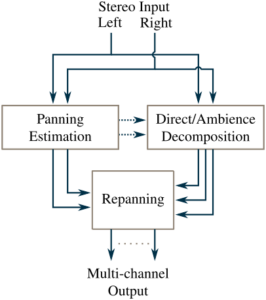Stereo recordings intended for playback over two loudspeakers have been the standard format for the majority of listeners in particular in the home and consumer area for many decades. In recent years and with the advent of surround sound, the playback hardware transitioned from classical two speaker hi-fi systems towards multifaceted integrated sound bars and surround speaker setups but music is still nearly exclusively produced and distributed in a two channel stereo format and listeners can not directly take benefit from multi-channel loudspeaker setups.

The process of generating additional loudspeaker signals from source material with fewer channels than available speakers is called upmixing. Typically, this means to convert 2-channel recordings into multi-channel surround formats. The developed algorithm is based on the description of a stereo or multi-channel recording as the weighted sum of direct signal sources overlaid with an uncorrelated ambient signal and incorporates the following processing steps:
- The azimuth position or panning coefficients of the sources are estimated under the assumption that only one dominant source is active at a single time-frequency instant.
- The direct and ambient components are separated with the knowledge of the panning coefficients.
- Having the separated signals with related source positions it is possible to remix the original content targeting any different loudspeaker configuration.

Key features
- VST-Plugin prototype
- Upmix of 2-channel stereo to 3.1, 4.1, 5.1, 8.1 and 9.1 channel configurations
- Up to 8 independent ambient channels in two layers
- Neutral sound, no additional reverberation or effects
- Low complexity
- Downmix compatible ambient signals
Demo
Complete upmixes from stereo to 5-channel surround and 9-channel 3D audio are available for download. The package includes the original stereo tracks as well as isolated tracks with the extracted direct and ambient components.
Download: HSU_Upmix.zip ( 417 MB)
Publications
[1] S. Kraft, U. Zölzer: “Time-domain implementation of a stereo to surround sound upmix algorithm”, 19th International Conference on Digital Audio Effects, 2016, Brno, Czech Republic.
[2] S. Kraft, U. Zölzer: “Low-complexity stereo signal decomposition and source separation for application in stereo to 3D upmixing”, 140th AES Convention, 2016, Paris, France.
[3] S. Kraft, U. Zölzer: “Stereo signal separation and upmixing by mid-side decomposition in the frequency-domain “, 18th International Conference on Digital Audio Effects, 2015, Trondheim, Norway.
[4] M. Fink, S. Kraft, U. Zölzer: “Downmix-compatibe conversion from mono to stereo in time- and frequency-domain “, 18th International Conference on Digital Audio Effects, 2015, Trondheim, Norway.
[5] S. Kraft, M. Fink, und U. Zölzer: “Low-cost and downmix-comopatible mono-to-stereo upmix”, Poster at 28th Tonmeistertagung (TMT28), Cologne, Germany, November 20-23, 2014
Letzte Änderung: 22. October 2019